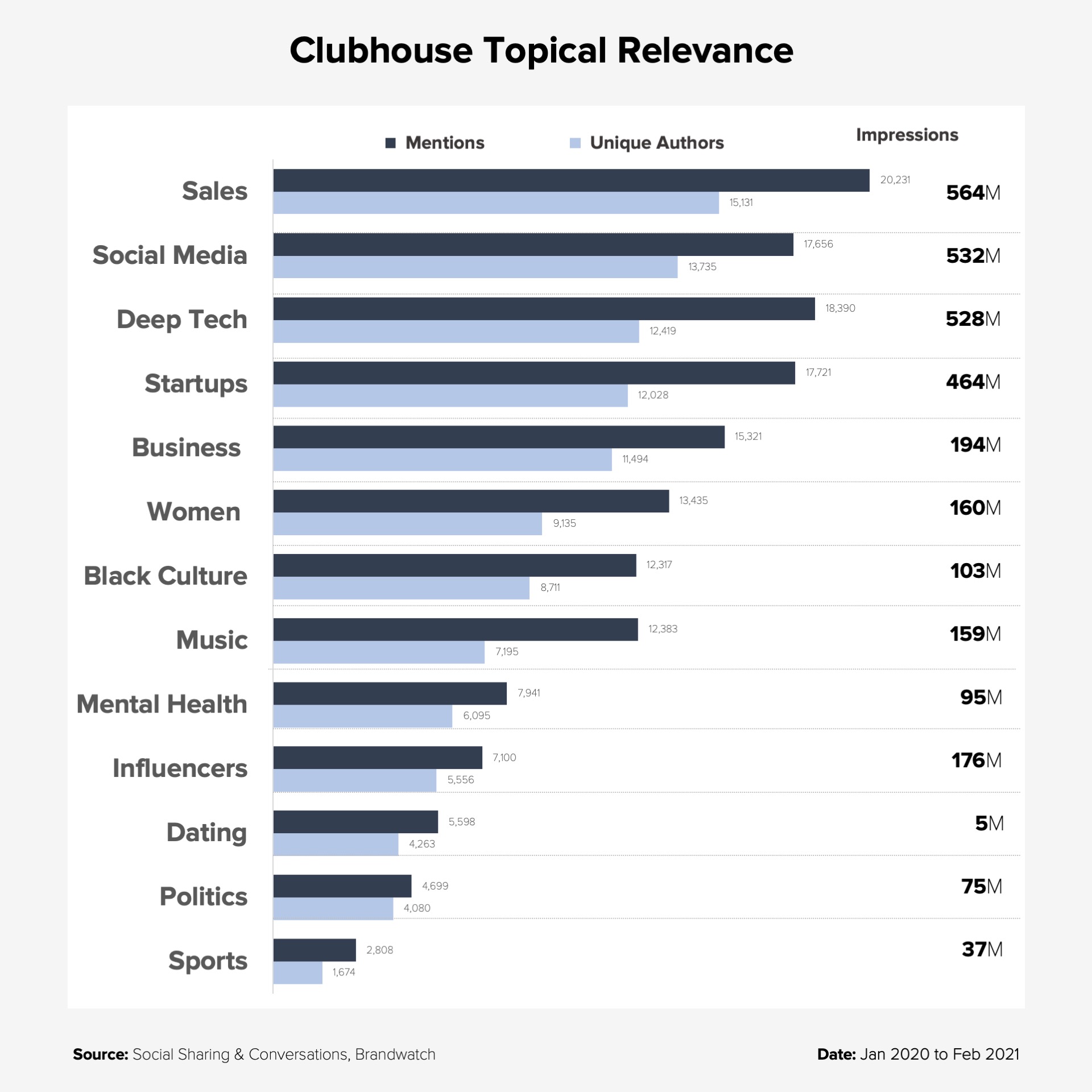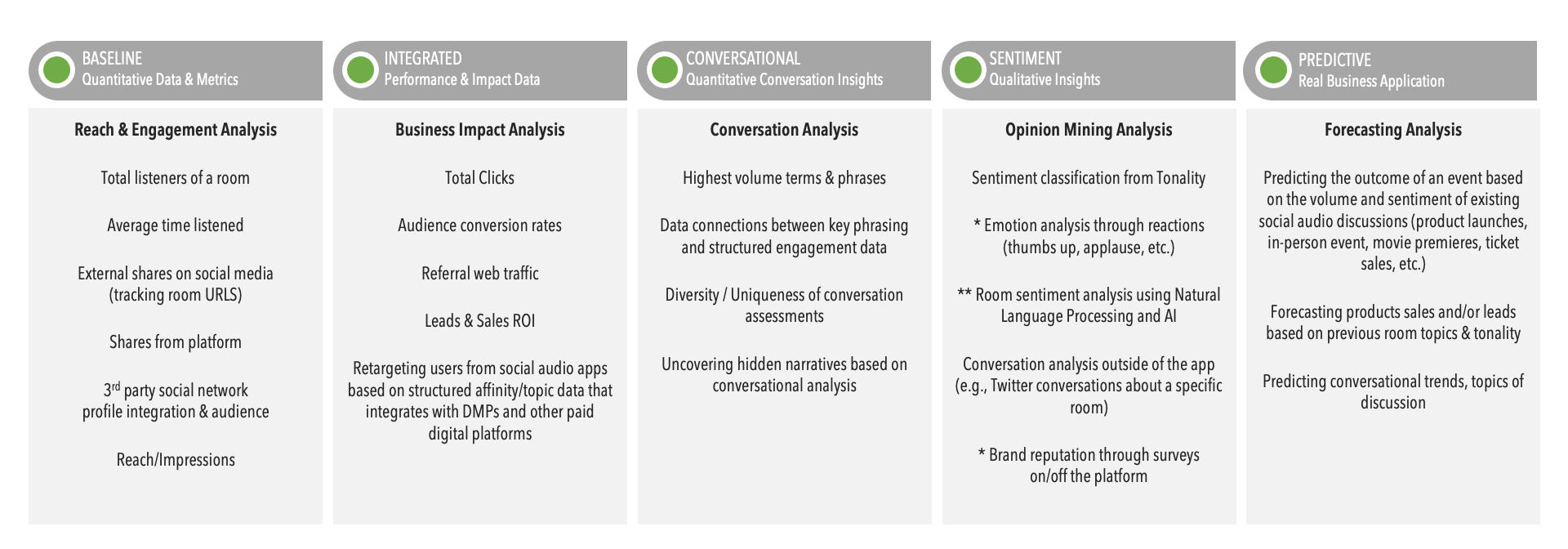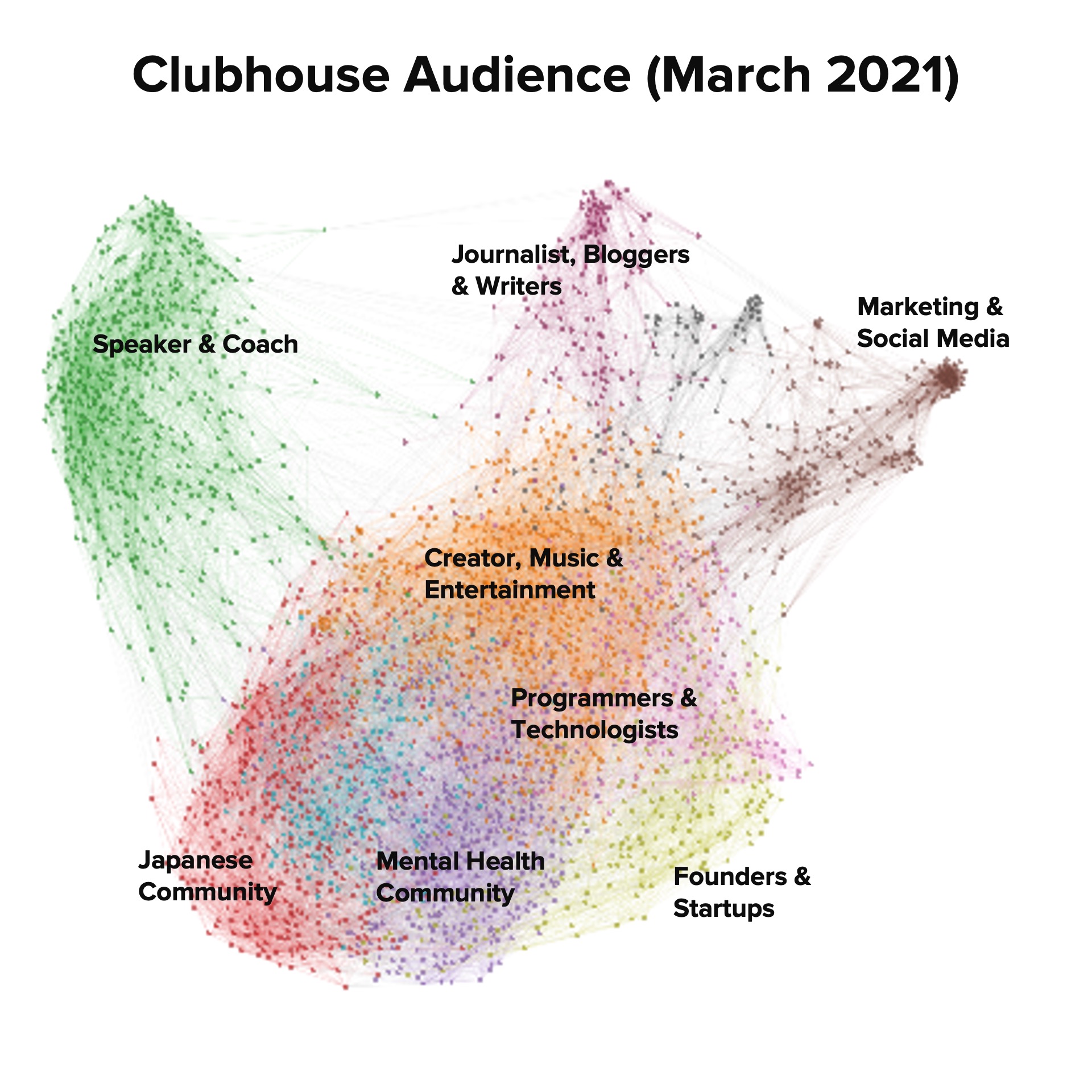Data doesn’t lie. The buzz and conversation around Clubhouse declined exponentially, for a good reason. Some say it turned into a platform for elitists. And the rise of Twitter Spaces and the plethora of other social audio apps didn’t help either.
A quick scan of Clubhouse data shows the topics most discussed on the platform. The topics range from sales and social media to dating and politics. The rooms I used to attend were all about people telling others about the future of Clubhouse, how to be a good Clubhouse moderator or why Clubhouse is better than Twitter Spaces. Sounds kind of elitist to me.
Snapshot of Clubhouse Analytics
The following Clubhouse data-driven insights are based on conversations on social media channels and Clubhouse room titles and clubs.

Clubhouse Analysis: Measuring Social Audio
Before you read on, it’s critical to view Clubhouse as just one piece of the larger social audio ecosystem. Therefore, if you are trying to build a measurement framework, you should look at all the possibilities beyond just Clubhouse insights.
The following framework is based on what’s currently possible with data & analytics and the future state of the industry. See below for one way to measure Clubhouse room analytics and general social audio engagement.

Review of Clubhouse Analytics Tools
Here’s a list of tools that pull Clubhouse insights and data.
- Direcon: This is the OG Clubhouse analytics tool. They were the first analytics platform for Clubhouse. They have also integrated additional social audio apps into their analytics suite–Twitter Spaces and Spotify Greenroom. They provide detailed insights about Clubhouse rooms, audience insights, interests, and demographics. And they also provide users with insights into the best-performing rooms, topics, and moderators of specific clubs.
- Clubhouse Tools: A Clubhouse app that provides a Clubhouse analysis and tracks room engagement. They also offer a historical analysis of previous rooms and clubs and a weekly report.
- ClubHub: Provides a deep dive into Clubhouse analytics and statistics. The tool provides average listener time, speaker time, unique users, unique speakers, bounce rate, and room duration. Users can download a list of Clubhouse room visitors with the pro account. They also provide Clubhouse audience data and can segment them by their interests.
- Clubhouse Database: This is a helpful tool that lists all the top users of Clubhouse. It has a search function for Clubhouse users and clubs.
Whatever tools you use to gather Clubhouse insights, it’s critical to demonstrate the business value and ROI of participating in Clubhouse as a marketing and communications channel.
Clubhouse Audience Analysis: How Social Audio Data is Changing
Updated on 3/21
With all the hype about Clubhouse and other social audio applications, we analyzed the Clubhouse audience data to understand how the audience is changing from early adoption to two more mainstream usage. In early 2020, there were three core Clubhouse audiences–the media, also referred to as the Technology Editors, Founders & Start ups, and Creators working in the music and entertainment industry.
The Clubhouse statistics below were collected using social handles promoting rooms or talking about the rooms they attended. The data was clustered and analyzed based on bio descriptions and follower relationships.
We also looked to see what was trending on Clubhouse.
The Clubhouse audience data below is a double click on the audience based on core demographics, unique interests, and media affinities.
You’ll notice that this segment of the Clubhouse audience looks like “Silicon Valley Insiders,” which is expected. Most of the early users were founders, VCs, and investors located in Silicon Valley and San Francisco.
We then explored a new data set of social handles collected over the last four months, from October 2020 to February 2021. The methodology was the same. We collected the social handles of those talking about Clubhouse rooms and inviting others to attend.
As you can see, the Clubhouse audience has shifted and has become more diverse. The core audience segments are the following:
- Female Business & Strategists
- Founder & Startups (Consistent with the original audience)
- Tech & Social Media
- UK & Nigerian Technologists
- Black Entrepreneurs
The social audio platform continues to grow exponentially and adds new users daily. Based on the Clubhouse analysis and data, it’s safe to say that the audience will continue to shift, grow and change until it reaches mass adoption.
Like the original audience above, we double-clicked on the current Clubhouse audience to understand the basic demographics, interests, and media affinities to see how it has changed.
As already mentioned, this Clubhouse audience has become more diverse, from 66% males to just 52%. The diversity in the profession is also expanding and changing.
Updated Clubhouse Audience Analysis, March 2021
My Clubhouse audience analysis is evolving by the day. And, when android users can finally join the party, it will look nothing like what you see below. The thing to remember here is that this data is based on how users describe themselves in their bio, and it’s not mutually exclusive. In other words, if I say that I am a “Founder” of a startup and a “Programmer” by trade, the bio-data will show up twice.
My observations of Clubhouse so far.
Topically, the rooms and topics are all over the place. Over the last three months, I’ve learned that Clubhouse users (especially moderators) are getting good at writing headlines. But just like with headlines, the content must live up to the expectations, and often, it doesn’t.
Also, there seems to be a hierarchy forming as users are clout chasing in the app. The attitude is very authoritarian and elitist, with some even having a courtroom vibe. Also, there is a lot of snake oil spreading in the app with headlines like “Get 1 Million Followers With Very Little Effort,” so don’t believe everything you hear. Do your research. Google the moderators, and you may be surprised by what you find.
The bio-data from this Clubhouse audience analysis was extracted using Audiense and visualized with Graphext.

Sorry, no Gen Z audience quite yet. Even though the data is changing, it is clear that Clubhouse has become a place to drive influencer conversations. Still today, I see B2B tech influencers talking about issues like artificial intelligence, 5G, and cyber security. Brands must stay connected to understand the opportunity even though the data changes, which is the case for most new social audio platforms.
Clubhouse News: What’s the Buzz on Social Audio Apps?
Social audio is taking the Internet by storm, and Clubhouse news is leading the way. Over the last six weeks, my feed on LinkedIn, Twitter, and other social platforms has been filled with people inviting me to their rooms on Clubhouse or talking about their personal experiences while in Clubhouse rooms.
Social media is just one piece of the trending conversation. Traditional media coverage is all over it. While Clubhouse news is dominating the headlines globally, there are other topics that the media is writing about regarding social audio. Everything from social audio’s impact on social networking to Elon Musk and the drop in conversations he has had over the last few weeks. The media is also fascinated with the growth trajectory of Clubhouse, Twitter’s launch of Twitter Spaces, and the rumors that Facebook will launch its social audio platform.
The below data shows a media analysis related to social audio and Clubhouse news.
The graph below represents the top media publishers by volume. It’s a pretty straightforward data point. It means that Business Insider, NBC News, Forbes, and Medium are the top 4 media publications covering the social audio space based purely on the number of articles they write about.
While Clubhouse news is the primary narrative driver, there are over 30+ social audio apps in the market, so we’ll start to see this shift.
While the below graph looks similar, the data is much different. This represents the top publishers by resonance. In other words, when Hot New Hip Hop, Business Insider, NBC News, and the LA Times write about social audio, it resonates with their audience of readers.
In this regard, resonance equals engagement in the form of social action-like comment, share, RT, or inbound link. And it does make sense if you think about it. If I read an article from NBC News about social audio and find it insightful, I will most likely share it on my network.
Here are more Clubhouse analytics resources for you:
